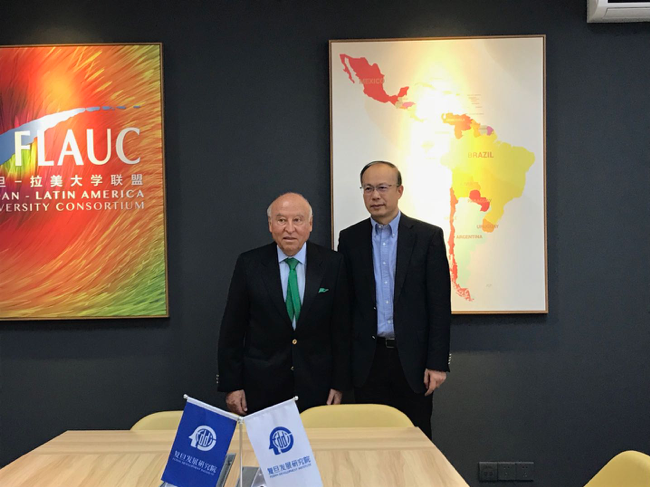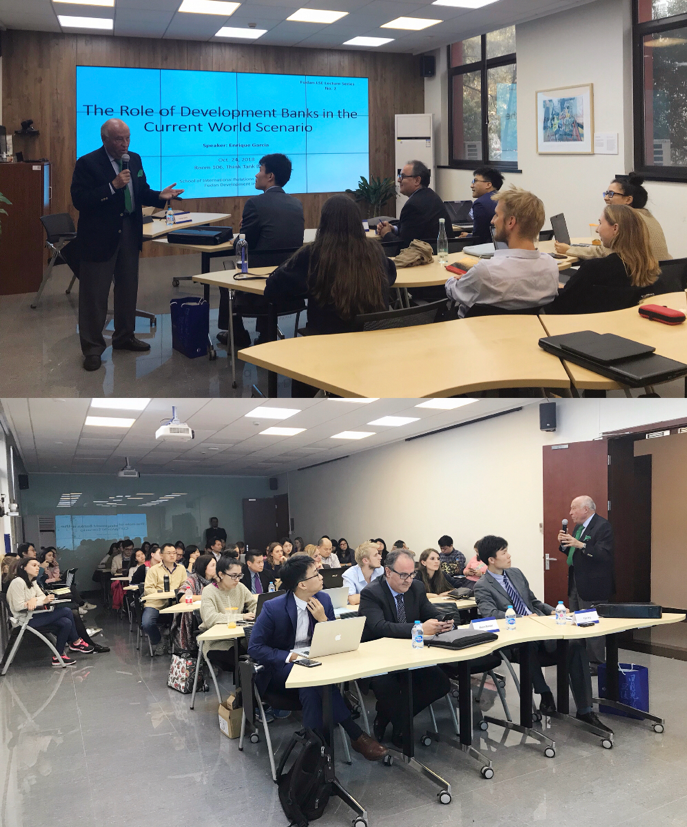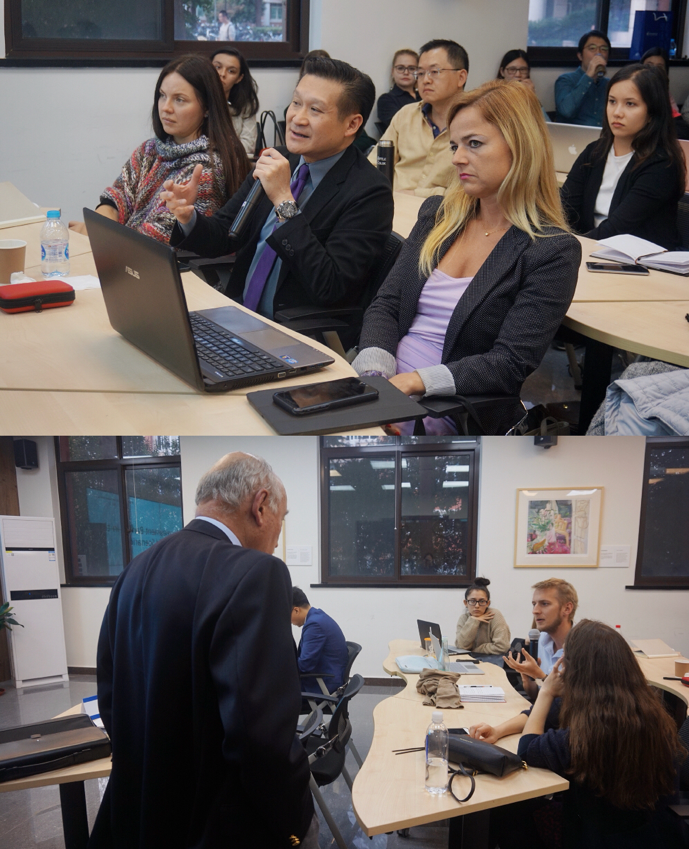The seventh lecture of “Latin America and China” series was successfully held by Fudan Development Institute and School of International Relations and Public Affairs on 24th October, 2018. The main topic of the lecture is “The Current World Situation and The Future of Development Bank” and the speaker is Enrique Garcia, former president of the Latin American Development Bank. It’s also the second Fudan-LSE series lecture. This lecture was hosted by Pro. Jing Yijia from School of International Relations and Public Affairs and visiting scholar Alvaro Mendez from London School of Economics. Prof. Zheng Yu and Dr. Zhao Jianzhi from School of International Relations and Public Affairs have also attended this lecture. Professor Chen Zhimin, Vice President of Fudan University, met with Mr. Garcia and expressed warm welcome to the guests. They exchanged ideas on how to deepen cooperation in multilateral development banks.

At the beginning, Professor Jing Yijia introduced Mr. Enrique Garcia to the audience. Enrique Garcia is the former President of CAF - Development Bank of Latin America for five terms of 26 years from 1991 to 2015. He is a Bolivian economist with wide experience in Latin American economic integration and international economic affairs. Between 1989 and 1991 he was Minister of Planning and Chief of the Economic and Social Cabinet of the Bolivian Council of Ministers. During that time he was Governor of his country to the World Bank, the Inter-American Development Bank and a Member of the Development Committee of the International Monetary Fund. Until 1989 and for seventeen years he worked for the Inter-American Development Bank where he reached the position of Treasurer. He graduated from economics at the St. Louis University where he also obtained an M.S. in Economics and Finance. He obtained a Ph.D. in Economics at the American University. He has taught economics at the Universidad Mayor de San Andrés and the Universidad Católica, both based in Bolivia.
When it comes to the lecture part, Mr. Enrique Garcia firtly made us understand what development bank is and why development banks are existent. Development banks exist because private sector funding channels were not financing areas that have an impact on development: infrastructure, education, energy, water and healthcare, communication, etc. These areas normally require long-term (10-15 years) and large amount of financing, which means that the private sector is not interested. After WW2, the Bretton Woods was built and IMF and World Bank were created. As for World Bank, originally it was designed to reconstruct the Europe just as its name IBRD – International Bank for Reconstruction and Development indicates, but then, it evolved to support developing countries for their infrastructure projects, including Latin America.And IDB was founded in 1960s, doing the same thing in one region –Latin America. There is a partnership between donor US and the western hemisphere. New players have appeared afterwards like AfDB and ADB, and more recently we see the creation of AIIB and NDB.
Mr. Enrique Garcia then gave us a broad picture of the history of Latin America and Why CAF was born and has been this useful. Latin America has very abundant natural resources and very important cultures. Colonized in 1492, there was a dual society in which one group was very rich, and the other was working very hard but not benefiting from it. Latin America has followed an export-oriented model focusing on its comparative advantage in raw materials. However, it has been very vulnerable and sensitive to fluctuations in commodity prices. Crash after WWI and Great Depression – many countries with high external debt defaulted. In 1950s, Latin America moved to a model of ISI (Import Substitution Industrialization) –which encouraged the government not to remain exclusively on the traditional exports of raw materials but to try to move to industrialization and start with high protectionism. The result was good in 1960s, in any books and articles at that time, you see that the Brazil was called as a prosperous country and the country of future. In 1970s, middle east discovered oil and have substantial commercial resources which were channeled through commercial banks to the countries in Latin America region. In 1980s, Mexico was the first to have a default in 1983. And that created a negative impact on other countries. Latin America didn’t have growth in 1980s and a profound adjustment was needed. In 1990s, several governments had a common view on bringing so-called “neoliberal” development strategies to Latin America. Growth was relatively modest and the impact on the lower classes was not good. In 2000s, socialist governments have advocated for pro-poor growth, but then 2008 crisis hit and there is a crash. It is the time to think what are the Challenges of Latin America and What is the role of Development Banks in the Region to deal with the challenges. Latin America needs a different type of growth – not the one based on commodities. The key lies in education, technology, and innovation.

Afterwards, Mr. Garcia analysed the challenges facing Latin America countries, Latin America has been too dependent on commodity prices. When prices go up, they have growth; but when it goes down, the growth disappear. This was because the high concentration in a few natural resource exports, unhealthy saving and investments ratios, low productivity and failure in poverty reduction.What is necessary for Latin America to do? A long-term systematic view and vision that integrate issues of microeconomic stability, microeconomic efficiency, social inclusion and sustainable development. Latin America needs to have stable governments and its own plans.
Lastly, he shared us his view on what the role of those development banks is and offered some instructive ideas for newly-founded Multilateral Development Banks. Precisely, it is to support the development of countries, not only with financial resources in helping close the gap between internal savings and investment requires, but also with technical know-how to support them with technical cooperation and knowledge transfer in preparation of plans, capacity to prepare projects/programs that include different technical, financial, economic, social and environmental affairs. Secondly, the role is also to attract other players to co-finance. Finally, the role is to strengthen the process of integration in that region. New development banks can be very successful if they follow the pattern of thinking that it is not just about financing, it is also about knowledge-sharing, institutional building, transparency in procurement, best practices experiences promotion around the world. New development banks should also corporate within institutions.

The series lecture of “Latin America and China” invites well-known experts and scholars in the field of Latin America studies from China and abroad, covering a wide variety of issues including Sino-Latin America economy, politics, society, international relations, culture, literature, film and media.The series lecture has not ended yet, please follow the Wechat subscription account of Fudan Development Institute(“复旦发展研究院”) to get the latest news.
Written by: Wu Zetao;
Photo: International Office of the School of International Relations and Public Affairs;
Edited and translated by Xu Junhui
